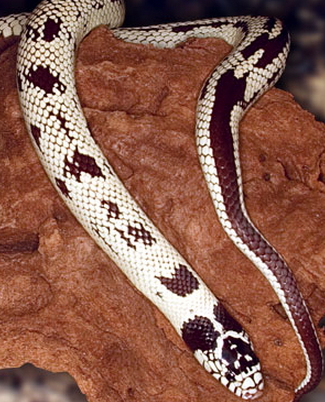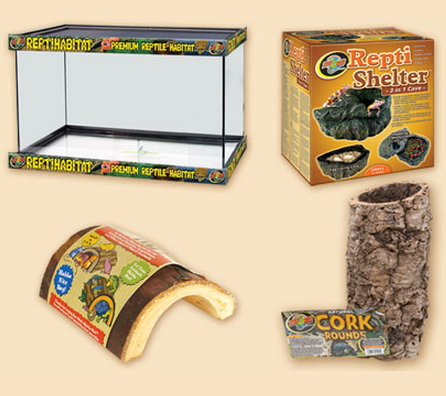Kingsnake
Home » Care Sheets » Kingsnake

Kingsnakes are among the most beautiful snakes in the world and have been popular pets in the reptile hobby since the beginning. There are many different types of kingsnakes found in North America, and care requirements are very similar for all of them. Kingsnakes were given their name because they are the “King” of snakes in America. They are considered “Kings” because they regularly eat other species of snakes in the wild, including rattlesnakes!
- Common Name: Common Kingsnake
- Scientific Name: Lampropeltis spp.
- Distribution: Found throughout the southern United States west into California.
- Size: 3′-6′
- Life Span: 15-20 yrs.+
HABITAT
HEATING
LIGHTING
SUBSTRATES
NUTRITION
HABITAT
- Hatchling to juvenile kingsnakes (under 18″) can be housed in a 10 gallon terrarium.
- Adult kingsnakes will need at least a 20-30 gallon terrarium. We recommend keeping snakes in an enclosure that is no shorter than half the length of the snake.
- A secure, lockable slidingscreen lid is essential for safely housing these snakes.
- Zoo Med’s ReptiHabitat™ terrariums are an excellent choice for kingsnakes.
- A Repti-Shelter™, Habba Hut™, or Cork Bark will provide a secure hiding place to help reduce stress.

HEATING
- Daytime Terrarium Temperature 75-80°F
- Basking Temperature 85-88°F
- Nighttime Terrarium Temperature 72-75°F
- Create a thermal gradient in your snake enclosure by placing a heat lamp and an Under Tank Heater on one side of the terrarium. Zoo Med’s Daylight Blue Reptile Bulb is a good choice for heating snake enclosures. By placing the heating elements on one side of the cage, you will naturally provide the proper thermal gradient.
- Any of Zoo Med’s thermometers will help you keep a close eye on terrarium temperatures.
- Keep all hides, such as a Repti-Shelter™ or Habba Hut™ on the cool end of the enclosure.
- A ReptiTherm® Under Tank Heater or ReptiCare™ Rock Heater is essential to provide belly heat to your snake while it digests a meal.

LIGHTING
- Snakes typically do not require UVB to meet their vitamin D requirements. However, many snakes receive UVB and sunlight in their natural habitat and there is new evidence that they benefit from UVB lighting in captivity.
- Zoo Med’s NatureSun® or ReptiSun® fluorescent lamps can be used to illuminate your terrarium and create a natural day/night photoperiod.

SUBSTRATES
- Kingsnakes will do best on Zoo Med’s Aspen Snake Bedding™, Forest Floor™ cypress mulch, or ReptiBark®. We recommend a substrate layer of 2-3″ in depth.
- Provide moistened New Zealand Sphagnum Moss in a Repti Shelter™ to create a humidity chamber. This chamber will help your snake shed its skin as it grows.
- Zoo Med’s Eco Carpet™ can be used as a safe, environmentally friendly, and easy-to-clean substrate.

NUTRITION
- Kingsnakes can be fed exclusively mice and small rats throughout their lives. Rodents provide snakes with the needed calcium and vitamins so additional supplementation is not needed.
- Have fresh water available at all times. ReptiSafe® Water Conditioner is a good choice for removing Chlorine and Chloramines from tap water.
- Zoo Med’s Corner Bowls are an excellent choice of water bowls for all snakes.
- When choosing the proper sized food item for your snake select a mouse/rat that is the same size, or slightly bigger than the girth of your snake.
- Hatchlings: Will eat 1 pinkie mouse per week.
- Juveniles: Will eat 1 hopper-adult mouse per week.
- Adults: Will eat 1-2 adult mice per week. Particularly large Kingsnakes will eat 1 appropriately sized rat per week.

